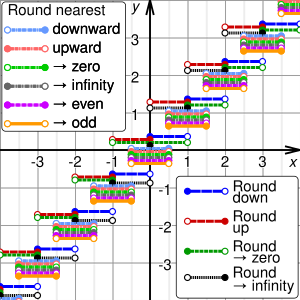-
- Rounding means estimating the exact value of a given number
- With the exception of the smallest place occupied by a digit in a number, a number can be rounded to any place that its digits occupy such as the hundreds, ones, tenths, hundredths (rounding target)
- The determination on whether a number is rounded up or down is based on the digit that occupies the place to the immediate right of the digit in the place that is the rounding target
- If the digit to the immediate right is greater than or equal to 5 (≥ 5), then the digit in the place that is the rounding target is increased by 1 (rounded up); and if the digit to the immediate right is less than 5 (< 5), then the digit in the place that is the rounding target does not change (rounded down)
- Notable mnemonic: 5 or more, raise the score–4 or less, let it rest
- With respect to rounding to whole number places (…, hundreds, tens, ones), the digit or digits to the immediate right of the rounding target are changed to 0s
- Example: 1,453 rounded to the nearest hundred (rounding target) is equal to 1,500
- With respect to rounding to decimal number places (tenths, hundredths, thousandths,…), the digit or digits to the immediate right of the rounding target are dropped
- Example: 4.463 rounded to the nearest tenth (rounding target) is equal to 4.5 since the digit to the immediate right of the tenths place (6) is greater than or equal to 5; and 4.463 rounded to the nearest hundredth (rounding target) is equal to 4.46 since the digit to the immediate right of the hundredths place (3) is less than 5
- The smaller the rounding target is, the more precise or closer approximation of the exact value of a given number
- Example: 23.458 rounded to the nearest hundredth (23.46) is more precise than 23.458 rounded to the nearest tenth (23.5) because the place value of the digit in the hundredths place (0.05) is smaller than the place value of the digit in the tenths place (0.4)
- Rounding is useful to express an estimation of a non-terminating decimal number such as pi (π)
- Like other currencies around the world, US Dollar amounts are often rounded to the nearest hundredth (two decimal places)
- In other words, rounding is useful when the exact value of a number is not needed or known
This article needs additional citations for verification. Please help improve this article by adding citations to reliable sources. Unsourced material may be challenged and removed. Find sources: "Rounding" – news · newspapers · books · scholar · JSTOR (October 2017) (Learn how and when to remove this template message) |

Rounding means replacing a number with an approximate value that has a shorter, simpler, or more explicit representation. For example, replacing $23.4476 with $23.45, the fraction 312/937 with 1/3, or the expression √2 with 1.414.
Rounding is often done to obtain a value that is easier to report and communicate than the original. Rounding can also be important to avoid misleadingly precise reporting of a computed number, measurement or estimate; for example, a quantity that was computed as 123,456 but is known to be accurate only to within a few hundred units is usually better stated as "about 123,500".
On the other hand, rounding of exact numbers will introduce some round-off error in the reported result. Rounding is almost unavoidable when reporting many computations – especially when dividing two numbers in integer or fixed-point arithmetic; when computing mathematical functions such as square roots, logarithms, and sines; or when using a floating-point representation with a fixed number of significant digits. In a sequence of calculations, these rounding errors generally accumulate, and in certain ill-conditioned cases they may make the result meaningless.
Accurate rounding of transcendental mathematical functions is difficult because the number of extra digits that need to be calculated to resolve whether to round up or down cannot be known in advance. This problem is known as "the table-maker's dilemma".
Rounding has many similarities to the quantization that occurs when physical quantities must be encoded by numbers or digital signals.
A wavy equals sign (≈: approximately equal to) is sometimes used to indicate rounding of exact numbers, e.g., 9.98 ≈ 10. This sign was introduced by Alfred George Greenhill in 1892.
Ideal characteristics of rounding methods include:
- Rounding should be done by a function. This way, when the same input is rounded in different instances, the output is unchanged.
- Calculations done with rounding should be close to those done without rounding.
- As a result of (1) and (2), the output from rounding should be close to its input, often as close as possible by some metric.
- To be considered rounding, the range will be a subset of the domain. A classical range is the integers, Z.
- Rounding should preserve symmetries that already exist between the domain and range. With finite precision (or a discrete domain), this translates to removing bias.
- A rounding method should have utility in computer science or human arithmetic where finite precision is used, and speed is a consideration.
But, because it is not usually possible for a method to satisfy all ideal characteristics, many methods exist.
As a general rule, rounding is idempotent; i.e., once a number has been rounded, rounding it again will not change its value. Rounding functions are also monotonic; i.e., rounding a larger number results in the same or larger result than rounding the smaller number.
